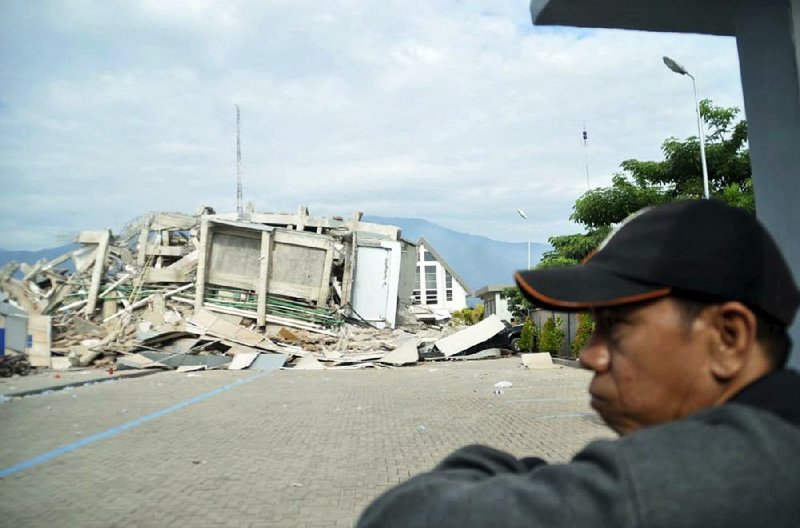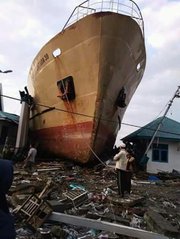PALU, Indonesia -- Residents too afraid to sleep indoors camped out in the darkness Saturday while survivors recounted harrowing stories of being separated from their loved ones a day after a powerful earthquake triggered a tsunami that unleashed waves that towered as high as 20 feet, killing hundreds on the Indonesian island of Sulawesi.
The official death toll stood at 405, with all the fatalities coming in the hard-hit city of Palu, but it was expected to rise once rescuers reach surrounding coastal areas, said disaster agency spokesman Sutopo Purwo Nugroho.
"We have found corpses from the earthquake as well as bodies swept up by the tsunami," Nugroho said in a television interview.
He said others were unaccounted for, without giving an estimate. The nearby cities of Donggala and Mamuju also were ravaged, but little information was available because roads were damaged and telecommunications disrupted. Vice President Jusuf Kalla told a news website that thousands may have died, with an unknown number washed out to sea.
Nugroho said "tens to hundreds" of people were taking part in a beach festival in Palu when the tsunami struck at dusk Friday. Their fates were unknown.
Hundreds of people were injured, and hospitals, damaged by the magnitude-7.5 quake, were overwhelmed.
Some of the injured, including Dwi Haris, who suffered a broken back and shoulder, rested outside Palu's army hospital, where patients were being treated outdoors as strong aftershocks continued. Tears filled his eyes as he recounted feeling the violent earthquake shake the fifth-floor hotel room he shared with his wife and daughter.
"There was no time to save ourselves. I was squeezed into the ruins of the wall, I think," said Haris, adding that the family was in town for a wedding. "I heard my wife cry for help, but then silence. I don't know what happened to her and my child. I hope they are safe."
It's the latest natural disaster to hit Indonesia, which is frequently struck by earthquakes, volcanic eruptions and tsunamis because of its location on the "Ring of Fire," an arc of volcanoes and fault lines in the Pacific Basin.
Indonesian President Joko Widodo called on citizens to pray for the affected region and said he had asked ministers and agencies to head to the region and assist with relief work.
The Indonesian Red Cross is sending ambulances and water trucks to the region, and distributing tarpaulins, blankets, sleeping mats and other supplies. But getting supplies to the region will be difficult with the road from Poso, a major town in Central Sulawesi province that could be a supply link to Palu, damaged or blocked.
Palu is a three-hour flight across the Java Sea and Makassar Strait from Jakarta and is closer to the southern Philippines and eastern Malaysia than to Java, Indonesia's most populous island.
By late afternoon Saturday, the Palu airport, which had temporarily accommodated only propeller planes because of damage caused by the disaster, was reopened to relief flights.
SCREAMING, RUNNING
Palu, which has more than 380,000 people, was strewn with debris from the earthquake and tsunami. A mosque heavily damaged by the quake was half submerged and a shopping mall was reduced to a crumpled hulk. A large bridge with yellow arches had collapsed. Bodies lay partially covered by tarpaulins and a man carried a dead child through the wreckage.
The city is built around a narrow bay that apparently magnified the force of the tsunami waters as they raced into the tight inlet.
Indonesian TV showed dramatic smartphone video of a powerful wave hitting Palu, with people screaming and running in fear. The water smashed into buildings and the mosque.
Andri Manganti, a resident of Palu who lost his home in Friday's earthquake, said that no warning siren sounded before the tsunami struck the city.
Text messages that were supposed to warn locals of the possibility of a tsunami did not go out as planned because cellphone towers had been downed by the earthquake, Nugroho said.
Indonesia's meteorological and geophysics agency is facing criticism for having lifted its tsunami warning little more than half an hour after the earthquake struck. It is not yet certain whether the devastating wave struck before or after the tsunami warning was lifted.
Nugroho said Saturday that as he was preparing information to alert the public about the tsunami threat, the warning was abruptly halted by the geophysics agency.
Nina, a 23-year-old woman who goes by one name, was working at a laundry service shop not far from the beach when the quake hit. She said the quake destroyed her workplace, but she managed to escape and quickly went home to get her mother and younger brother.
"We tried to find shelter, but then I heard people shouting, 'Water! Water!'" she recalled, crying. "The three of us ran, but got separated. Now I don't know where my mother and brother are. I don't know how to get information. I don't know what to do."
The earthquake left mangled buildings with collapsed awnings and rebar sticking out of concrete like antennae. Roads were buckled and cracked. The tsunami created even more destruction. It was reported as being 10 feet high in some areas and double that height elsewhere.
Communications were difficult because power and telecommunications were cut, hampering search-and-rescue efforts. Most people slept outdoors, fearing aftershocks.
Indonesia is a vast archipelago of more than 17,000 islands that's home to 260 million people. Roads and infrastructure are poor in many areas, making access difficult in the best of conditions.
With so little information trickling out from areas outside the city, and based on Indonesia's tragic history with tsunamis, fears have multiplied that the final death toll could grow far worse.
Kalla, the vice president, noted that when the Indian Ocean tsunami struck on Dec. 26, 2004, the death toll recorded that night in Aceh, on the northern tip of the Indonesian island of Sumatra, was around 40 people. The eventual body count in Aceh exceeded 130,000. Overall, the tsunami killed more than 230,000 people.
Since the 2004 tsunami, Indonesia has strengthened its disaster response. A new disaster management agency was created, with provincial units that can report quickly to the center.
"It's quite a difference from Aceh times," said Selina Sumbung of the Save the Children charity in Indonesia. "Coordination is a lot better, and we find out information a lot faster."
But obstacles remain. Provincial authorities in Indonesia, who hold significant power, have had a habit of turning away offers of help from outsiders, international charities say.
VALOR IN TOWER
AirNav, Indonesia's air navigation agency, said one of its air traffic controllers died in the quake after staying in the tower to ensure a flight he'd just cleared for departure got airborne safely. It did.
In the wobbling air traffic control tower, as other personnel fled, Anthonius Gunawan Agung, 21, stayed put, helping guide the pilot down the runway. Moments after the plane went airborne, the earthquake intensified, and Agung leapt out of the tower as its roof collapsed, suffering a broken leg and internal injuries.
With the airport largely disabled, hours passed before a helicopter could arrive to take him to a hospital. Agung died early Saturday, officials said
As the pilot of Batik Air Flight 6231, Ricosetta Mafella, ascended over the coast, he noticed what he called on Instagram a "strange wave" -- a sign of the devastating tsunami that would soon sweep over Palu and other parts of Central Sulawesi province.
AirNav, which posted a series of messages on Twitter describing the moments at the airport during the earthquake, said it had posthumously promoted Agung, calling him one of its "warriors." Mafella called him a "guardian angel" on Instagram.
More than half of the 560 inmates in a Palu prison fled after its walls collapsed during the quake, said its warden, Adhi Yan Ricoh.
Ricoh said there was no immediate plan to search for the inmates because the prison employees and police were consumed with the search-and-rescue effort.
"Don't even think to find the inmates. We don't even have time yet to report this incident to our superiors," he said.
Information for this article was contributed by Niniek Karmini, Margie Mason and Stephen Wright of The Associated Press; by Hannah Beech, Muktita Suhartono and Richard C. Paddock of The New York Times; and by Shashank Bengali and Simon Roughneen of the Los Angeles Times.
A Section on 09/30/2018



